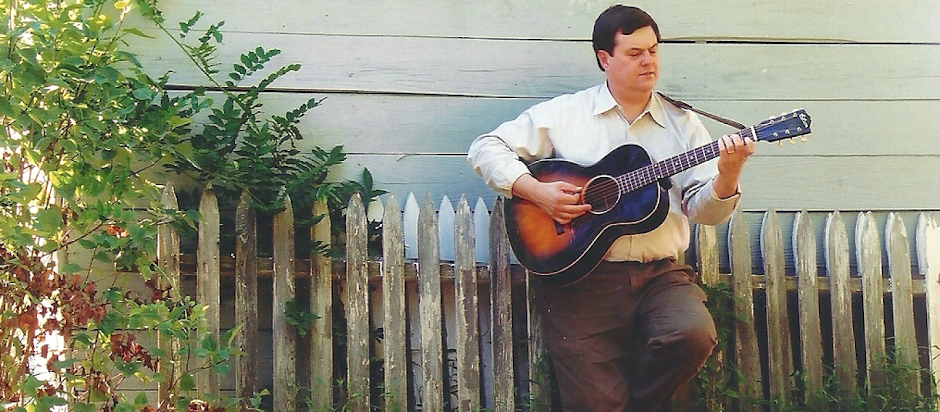Vintage Music News
No. 2 — Summer 2005
Vintage instruments in the collection
Ken Lelen has owned and played instruments built during the late 19th Century and early 20th Century by such venerable American firms as: Bacon & Day, Bay State, Carlstedt, Cole, Dobro, Emory, Epiphone, Gatcomb, Gibson, Gretsch, Harmony, Haynes, Kay, Larson, Lyon & Healy, Martin, Oahu, Regal, Schmidt, Stewart, Thompson & Odell, Vega, and Washburn.
Whether accompanying ragtime, jazz or swing favorites, they all make music that is striking for its tone, character and sustain — without the use of pick-ups or gimmicks. Vintage instruments currently [Summer 2005] in the collection include:
Whether accompanying ragtime, jazz or swing favorites, they all make music that is striking for its tone, character and sustain — without the use of pick-ups or gimmicks. Vintage instruments currently [Summer 2005] in the collection include:
1920 Galiano
 |
| Ken Lelen — with 1920 Galiano. |
Galiano was a low-cost brand offered by luthiers Rafaele Ciani (d. 1932) and Antonio Cerrito of Little Italy, NYC and Oscar Schmidt Co. of Jersey City NJ, which sold instruments through mail-order firms, dry goods stores and railway depots between 1900 and 1937. The renowned archtop guitar maker John D'Angelico (1905 - 1964) was an apprentice with Ciani, his great-uncle, between 1914 and 1932.
This concert-sized guitar originally sold for $8 wholesale, or $15 - $17 retail. It has a mahogany back and sides, ladder-braced spruce top, mother-of-pearl inlays on a pearwood fretboard, and wood perfling on the soundhole rosette, edge binding and backstripe. Despite its diminutive size, this instrument has a surprisingly huge, warm voice that's well-suited for ragtime, hokum and up-tempo harassment.
This concert-sized guitar originally sold for $8 wholesale, or $15 - $17 retail. It has a mahogany back and sides, ladder-braced spruce top, mother-of-pearl inlays on a pearwood fretboard, and wood perfling on the soundhole rosette, edge binding and backstripe. Despite its diminutive size, this instrument has a surprisingly huge, warm voice that's well-suited for ragtime, hokum and up-tempo harassment.
1932 Gibson L-00
This black-bodied guitar was built by the Gibson Co. of Kalamazoo, MI (original price: $25). It has mahogany back and sides, 12-fret neck, rosewood fretboard, X-braced spruce top and white celluloid pickguard. Offered just before steel-stringed, dreadnought guitars with booming sounds became widely available, it has a four-legged presence and formidable voice for its size. A date-stamped C.O.D. receipt, discovered under the guitar's adjustable truss rod cover, indicates the instrument was sold for $12.25 on July 29, 1937 in Roaring Spring, PA.
1936 Martin 00-18G
This instrument (original price: $45 with $15 plywood case) was the prototype for 5,138 classical-style guitars made by C.F. Martin Co. of Nazareth, PA between 1936 and 1962. It has mahogany back and sides, spruce top, 12-fret neck with slotted headstock, nickel-steel machines with ivoroid tuners, ebony fretboard and ebony bridge. Over its life of six decades, the guitar's powerful tone has mellowed to a deep, crisp and radiant sonority.
1937 Gibson HG-00
This is a wide-necked, 12-fret guitar that sold for $30 plus $5.50 for its flannel-lined, cardboard case and $1.50 for a set of metal strings. This beauty originally was designed for playing Hawaiian-style music, rather than Spanish, or standard style. One of 300 made between 1936 and 1942, its spruce top is finished in a glorious honey-hued sunburst. Today, its tone is as deep and resonant as its wine-red mahogany back and sides.
1939 Gibson L-0
Built as the Depression ended, this small-bodied instrument (original price: $27.50 in Oct., 1939) has a 14-fret neck and sweet, woody tone. The all-black body is adorned with a firestripe pickguard, rosewood bridge, and white celluloid binding along the edge of its mahogany back and spruce top.
1940 Gibson A-50
This mandolin has figured maple back and sides and sunburst spruce top. It has Nick Lucas-style inlays in a rosewood fretboard and peghead with flowerpot inlay and pearl-script logo. Introduced in 1933 with an oval soundhole, it gained f-holes in 1934 and slightly larger body in 1937. Though discontinued in 1942 by a wartime hiatus, professional musicians deemed the A-50 easy to play and affordable (original price: $55 plus $15.50 for a plywood case).
This A-50 was a gift from Ernst Koch (1906 - 2001) of Whiting, NJ, a Penn State graduate, WW II veteran, German language professor at New York University and original owner of the instrument. He began playing mandolin in 1916, paying $9 for a bowl-back mandolin and 75 cents for twice-weekly lessons from an Italian musician named Professor Moscati, a clerk in his father's woolen shop in Clifton, NJ. As a teenager, Koch also played in a 50-piece mandolin orchestra that held weekly practice sessions above an Italian saloon in Passaic, NJ, said Koch, who also learned to play archtop mandolin, banjo-mandolin, clarinet and saxophone.
"I bought this mandolin ... directly from the Gibson company, which mailed it to me," the Professor said. "I loved to play the mandolin and could play up to the seventh position. I found it a great emotional outlet."
1943 Martin 000-18
 |
| Ken Lelen — with 1943 Martin 000-18. |
_________________________________________________________
© 2005 Ken Lelen - All Rights Reserved

No comments:
Post a Comment